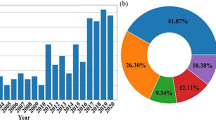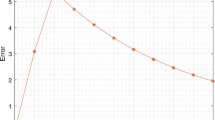Abstract
This paper focuses on the numerical solution for Volterra integral equations of the first kind with highly oscillatory Bessel kernel and highly oscillatory triangle function on the right-hand side. We first establish a new existence theorem of solutions for such equations, and then, the explicit formulas of the solution are derived based on Laplace and inverse Laplace transforms. Furthermore, high-order accurate numerical solutions for approximating the explicit solution are further deduced by applying the Clenshaw–Curtis–Filon method and other effective numerical methods. Preliminary numerical results not only show the exact formulas of the solution, but also present the accuracy of the approximations.


Similar content being viewed by others
References
Abramowitz M, Stegun I (1964) Handbook of mathematical functions. National Bureau of Standards
Branders RPM (1975) An extension of Clenshaw–Curtis quadrature. J Comput Appl Math 1:55–65
Brunner H (2004) Collocation methods for Volterra integral and related functional differential equations. Cambridge University Press, Cambridge
Brunner H (2010) On the numerical solution of first-kind Volterra integral equations with highly oscillatory kernels. Isaac Newton Inst HOP 13:17
Brunner AIH, Nørsett S (2007) Open problems in the computational solution of Volterra functional equations with highly oscillatory kernels. Effective computational methods for highly oscillatory solutions. Isaac Newton Institute, HOP
Brunner H, Davies PJ, Duncan DB (2009) Discontinuous galerkin approximations for Volterra integral equations of the first kind. IMA J Numer Anal 29(4):856–881
Burton TA (2005) Volterra integral and differential equations, vol 202. Elsevier, Amsterdam
Churchill RV (1971) Operational mathematics. McGraw-Hill College, New York
Davies PJ, Duncan DB (2004) Stability and convergence of collocation schemes for retarded potential integral equations. SIAM J Numer Anal 42(3):1167–1188
Davis P, Rabinowitz P (1984) Methods of numerical integration. Academic Press, New York
de Hoog F, Weiss R (1973) On the solution of Volterra integral equations of the first kind. Numer Math 21(1):22–32
Domínguez V, Graham I, Smyshlyaev V (2011) Stability and error estimates for Filon–Clenshaw–Curtis rules for highly oscillatory integrals. IMA J Numer Anal 31(4):1253–1280
Domínguez V, Graham I, Kim T (2013) Filon–Clenshaw–Curtis rules for highly oscillatory integrals with algebraic singularities and stationary points. SIAM J Numer Anal 51(3):1542–1566
Gripenberg G, Londen S-O, Staffans O (1990) Volterra integral and functional equations. Cambridge University Press, Cambridge
Hesthaven JS, Gottlieb S, Gottlieb D (2007) Spectral methods for time-dependent problems. Cambridge University Press, Cambridge
Jones DS (1964) Theory of electromagnetism. Oxford University Press, Oxford
Linz P (1971) Product integration methods for Volterra integral equations of the first kind. BIT 11(4):413–421
McAlevey L (1987) Product integration rules for Volterra integral equations of the first kind. BIT 27(2):235–247
Oliver J (1968) The numerical solution of linear recurrence relations. Numer Math 11(4):349–360
Polyanin AD, Manzhirov AV (1998) Handbook of integral equations. CRC Press, Boca Raton
Rynne BP, Smith PD (1990) Stability of time marching algorithms for the electric field equation. J Electromagn Waves Appl 4:1181–1205
Trefethen LN (2013) Approximation theory and approximation practice. SIAM, Philadelphia
Volterra V (1896) Sulla inversione degli integrali definiti. Atti R Accad Sci Torino Cl Sci Fis Mat Natur 31:311–323
Wang H, Xiang S (2011) Asymptotic expansion and Filon-type methods for a Volterra integral equation with a highly oscillatory kernel. IMA J Numer Anal 31(2):469–490
Xiang S (2014) Laplace transforms for approximation of highly oscillatory Volterra integral equations of the first kind. Appl Math Comput 232:944–954
Xiang S, Brunner H (2013) Efficient methods for Volterra integral equations with highly oscillatory bessel kernels. BIT Numer Math 53:241–263
Xiang S, Wang H (2010) Fast integration of highly oscillatory integrals with exotic oscillators. Math Comput 79(270):829–844
Xiang S, Chen X, Wang H (2010) Error bounds for approximation in Chebyshev points. Numer Math 116(3):463–491
Xiang S, Cho YJ, Wang H, Brunner H (2011) Clenshaw–Curtis–Filon-type methods for highly oscillatory bessel transforms and applications. IMA J Numer Anal 31(4):1281–1314
Xiang S, Li B, Liu G (2018) On efficient computation of highly oscillatory retarded potential integral equations. Int J Comput Math 11:2240–2255
Xu Z (2015) High performance algorithms and implementation of highly oscillatory integrals. Ph.D. thesis, Central South University
Funding
This work is supported partly by NSF of China (Nos. 11371376, 11771454), the Innovation-Driven Project, the Mathematics and Interdisciplinary Sciences Project of Central South University and the Fundamental Research Funds for the Central Universities of Central South University (No. 2017zzts060), the Natural Science Foundation of Hunan Province (No. 2017JJ3092), and scientific research project of Department of Education of Hunan Province (No. 17C0677).
Author information
Authors and Affiliations
Contributions
All authors contributed equally to the writing of this paper. All authors read and approved the final manuscript.
Corresponding author
Ethics declarations
Conflict of interest
All of the authors of this article claim that together they have no competing interests.
Additional information
Communicated by Hui Liang.
Publisher's Note
Springer Nature remains neutral with regard to jurisdictional claims in published maps and institutional affiliations.
Rights and permissions
About this article
Cite this article
Li, B., Xiang, S. & Liu, G. Laplace transforms for evaluation of Volterra integral equation of the first kind with highly oscillatory kernel. Comp. Appl. Math. 38, 116 (2019). https://doi.org/10.1007/s40314-019-0892-7
Received:
Revised:
Accepted:
Published:
DOI: https://doi.org/10.1007/s40314-019-0892-7




